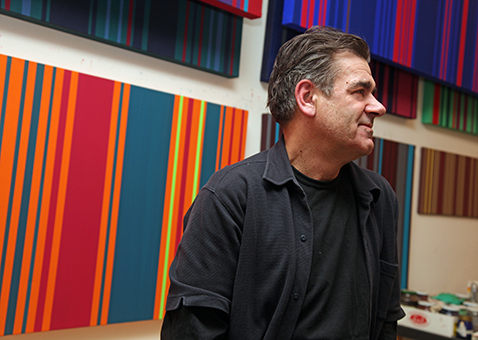wanderlust
A Colorful History

A few weeks ago I went to see a show at Kleine Humboldt Galerie featuring an international array of artists. The space was beautiful, the artwork was nice and the show’s amiable curator, Yasmin Meinicke, surprised me with an unexpected guest: Serbian artist and “father of Transfigurative Painting” Milovan Destil Markovi?. Exhibiting some newer “Barcoded” paintings, his work stood apart from the rest of the pieces in the show. Following a brief discussion regarding his life and paintings, I yearned to research him further. While investigating Markovi? I was shocked to find out just how impressive his practice was; a quick glance at his website revealed that he was featured in the Venice Biennial, PS1 Contemporary Art Center in New York, the Hamburger Bahnhof in Berlin and the São Paulo Biennial. I knew my short conversation with this art titan at Kleine Humboldt wasn’t going to satisfy my interest in his life and art, so I quickly contaced him in hopes we could meet again.
Spoiler Alert: He Agreed To An Interview
To be honest I wasn’t sure what to expect from Markovi?’s studio. I didn’t know if he worked in a century old, bombed out atelier or a sunlit contemporary loft. I was pleasantly surprised to see that he opted for something in-between. In a building off Jannowitzbrücke, Markovi?’s studio has housed his creative efforts for eight years. He greeted me there late in the evening, in his exceptionally clean studio with jazz playing softly in the background. Along the walls displayed in Salon style stacks were several versions of his barcoded paintings in multiple sizes. Opposite this private exhibition was a rather large library of writings on himself and his contemporaries. The studio was a nice dichotomy – the future and the past clashing alongside each other with Markovi? quietly painting in the middle.

Born in what was then Yugoslavia, Markovi? began painting at a young age. In the late seventies he began his art studies in Belgrade although he originally intended to study philosophy. It was here that he started to make a name for himself with full-scale installations and projects including concerts and events. Finally in 1986 he relocated to West Berlin where, with the exception of expeditions to Brazil and China, he has remained ever since. He was here when the Wall fell down on his birthday (November 9th) and was soon introduced to artists from the East for the first time. He recalls starting to work as an artist at Kunst-Werke Institute for Contemporary Art that carries on to this day. He tells me how Berlin has both changed and remained the same since he first arrived here: although the face of the city has transformed, the influx of artists and the amiable price of property has endured.
Be the first to write a comment.
Your feedback
